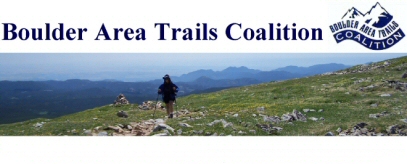

Homepage - Brochure - Application - Newsletters - Issues - Links - Weather - Board
The following city and county surveys all show strong support for recreational access to public lands. Yet all our land management agencies may not be getting the message. Sometimes it all depends on who's talking and what they chose to notice. It helps to see all the data. We suggest you review the referenced surveys below, read our comments, and make up your own mind.
Extreme Rhetoric: Who's Being Heard?
After more than a decade of involvement with issues concerning public land management, recreation, and the environment we've observed the same people expounding the same viewpoints over and over again in various public forums. The viewpoints they present are often extreme and their rhetoric emotional.
Issues concerning trails often prompt such presentations. Recent examples include opposition to a short trail because of presumed impacts on endangered swallows (there are no endangered swallow species) and opposition to a proposed Open Space purchase of a mountain building site because some of the property might be used for a trail (apparently a large trophy house would have less impact).
Since the squeaky wheel often gets the oil, it's important that we understand who is really being represented. Are our public land managers just hearing from a vocal minority or are they getting a balanced presentation of the community's consensus? Those speaking claim to represent a large, not present, majority. Based on county and city surveys things are not so black and white. There seems to be more balance in the public at large than we see represented in some meetings.
The survey data indicate that the vast majority of our citizens are both environmental and recreational supporters. In fact, the proportion of our citizens who see recreation as the primary purpose of open space is as large as the proportion who see environmental preservation as the primary goal.
The surveys show support for environmental protection and a public willingness to accept restrictions on recreational activities in sensitive areas. These responses are often cited. The survey data also show support for recreational activities and for providing additional land and trails for recreation. These responses are seldom cited. (We've included some survey data with recreational pertinence below. Use the links above for the full survey texts).
Although we applaud the dedication of our most concerned environmental advocates, we believe extreme positions tend to polarize the discussions and alienate potential allies. Recreational access and environmental preservation are not mutually exclusive. Nor are they seen to be by most of our citizens. If our land management programs are to be successful they need support from us all. A little more attention to all the public concerns and a little less emotional rhetoric would help immensely.
Louisville Open Space Survey 2003
Optimal use of Open Space
Recreation 48%
Wildlife 42%
Agriculture 10%
OS activities
Walking 92%
Bicycling 52%
Walking dogs 42%
Jogging 34%
Boulder County Surveys 1997/2002
Growth management is the biggest issue
County wide 46%/35%
Boulder City 44%/36%
OS activities judged "Very" or "Fairly" Important
Protecting wildlife habitat 96%/93%
Hiking 93%/91%
Preserving agricultural lands 90%/89%
Nature study 87%/84%
Growth management 86%/83%
Urban buffers 86%/79%
Mountain biking 61%/71%
Walking dogs 61%/73%
Horseback riding 57%/51%
Percentage of users who...(1997 Survey only)
Hike 93%
Bike 45%
Walk dogs 33%
Ride horses 12%
Boulder City OS Survey 1999
Primary purpose of open space:
Growth management 39%
Recreation 23%
Preserve wildlife & habitat 23%
Biggest concern with open space is crowding:
Crowded or moderately crowded 71%
How to deal with crowding
(appropriate or somewhat appropriate)
More user education 89%
Buy more land for recreation 87%
Building more trails & entrances 69%
(not appropriate)
Building more trails & entrances 10%